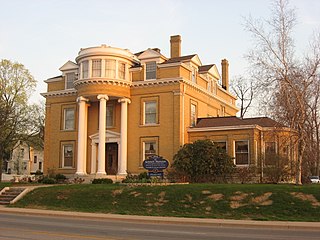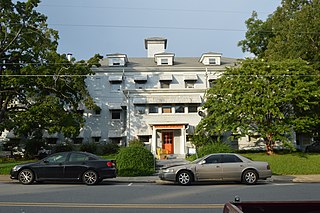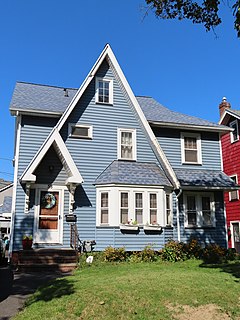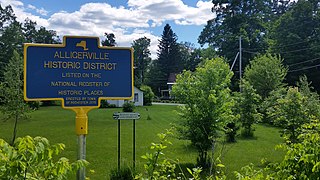
The East Main Street–Glen Miller Park Historic District is a neighborhood of historic residential buildings and national historic district located at Richmond, Wayne County, Indiana. The district encompasses 84 contributing buildings, 11 contributing structures, and 5 contributing objects along the National Road and sometimes called Millionaire's Row. A portion of the district is recognized by the City of Richmond's Historic Preservation Commission as the Linden Hill conservation district. It developed between about 1830 and 1937 and includes representative examples of Italianate, Queen Anne, Colonial Revival, Tudor Revival, Classical Revival, and Bungalow / American Craftsman style architecture. Located in the district is the separately listed Henry and Alice Gennett House. Other notable contributing resources include elaborate iron bridges and "Madonna of the Trail" statue located in Glen Miller Park, Isham Sedgwick House (1884-1885), John A. Hasecoster House (1895), William H. Campbell House (1905), Howard Campbell House (1909), E.G. Hill House, Crain Sanitarium, and Dr. T. Henry Davis House.

Reid Street–North Confederate Avenue Area Historic District is a national historic district located at Rock Hill, South Carolina. It encompasses 22 contributing buildings in a middle-class residential section of Rock Hill. The district developed between about 1839 and 1935. Architectural styles represented include Victorian, Classical Revival, Queen Anne, and Bungalow. Notable buildings include the Steed House, Bynum House, Jenkins House, and Gross-Brock House, along with the separately listed White House.

Chapel Hill Historic District is a national historic district located at Chapel Hill, Orange County, North Carolina. The district encompasses 46 contributing buildings, 2 contributing structures, and 2 contributing objects on the central campus of the University of North Carolina at Chapel Hill and surrounding residential sections of Chapel Hill. The district's buildings date from 1795 to the early-20th century and include notable examples of Classical Revival and Jacobean Revival architecture. Located in the district and separately listed are the Chapel of the Cross, Old East, building and Playmakers Theatre. Other notable contributing resources are the Davie Poplar, Old West (1822), South Building (1798), the Old Well, Person Hall (1797), Gerrard Hall (1822), New East, New West, the Joseph Caldwell Monument (1858), the Y.M.C.A. Building, Battle-Vance-Pettigre11 Dormitory (1913), Horace Williams House (1854), the Phillips Law Office, the Phillips House (1856), the Old Methodist Church (1853), Senlac, Hippol Castle (1920s), and Battle Park.

Central Leaksville Historic District is a national historic district located at Eden, Rockingham County, North Carolina. It encompasses 67 contributing buildings, 2 contributing sites, and 1 contributing object in a residential section of the town of Eden. It was developed from about 1815 to about 1935, and includes notable examples of Italianate, Queen Anne, Colonial Revival, and Bungalow style architecture. Notable buildings include the Rogers-Martin-Taylor House, Saunders-Hege House, Robinson-Dillard-Martin House, Lawson-Moir-Clayton House, Episcopal Church of the Epiphany (1844), J. M. Hopper House (1885), Norman-DeHart House, and Casteen House.

Canajoharie Historic District is a national historic district located at Canajoharie in Montgomery County, New York. It encompasses 836 contributing buildings, 4 contributing sites, 11 contributing structures, and 19 contributing objects in the central business district and surrounding residential sections of the village of Canajoharie. It developed between about 1750 and 1959, and includes notable examples of Greek Revival, Italianate, Queen Anne, Colonial Revival, Tudor Revival, and Bungalow / American Craftsman style architecture. Located in the district are the separately listed Bragdon-Lipe House, the Van Alstyne House, the West Hill School, and the United States Post Office. Other notable contributing resources include the Village Hall (1941), Canajoharie Creamery, Beech-Nut No. 1 Plant, Beech-Nut No. 2 Plant, Reformed church (1842), Episcopal Church of the Good Shepherd (1874), St. Mark's Lutheran Church (1868), Saints Peter and Paul Roman Catholic church, Sayles Building (1868), and the Arkell Foundation complex.

Scottholm is an historic housing development in the Meadowbrook neighborhood of Syracuse, Onondaga County, New York. It has been registered as a National Historic District. It is bounded by Salt Springs Road on the north; Brookford Road and East Avenue on the east; Meadowbrook Drive on the south; and Scottholm Terrace on the west. Scottholm consists of single‐family homes of varying styles built in the early 20th century. When it was built, Scottholm was marketed to upper middle class and upper class residents. Today, the area attracts a diverse population of white collar, academic, and creative class professionals. Nottingham High School, in the Syracuse City School District, is nearby.

Market Square Historic District is a national historic district located in the Black Rock neighborhood of Buffalo in Erie County, New York. The district encompasses 15 contributing buildings and 1 contributing site in a mixed residential and commercial section of Buffalo. The district developed between about 1830 and 1912, and includes a buildings in a variety of architectural styles including Federal, Gothic Revival, Italianate, Queen Anne, Romanesque Revival, and Bungalow / American Craftsman. Located in the district is the separately listed St. Francis Xavier Roman Catholic Parish Complex. Other notable contributing resources include the Market Square (1830), Black Rock Savings and Loan (1870-1910), Firehouse Engine #15 (1912), Smith House and Tavern, St. John's Church (1894), and Howell House and Store.

Broadway Historic District is a national historic district located at Lancaster in Erie County, New York. The district encompasses 85 contributing resources in the village of Lancaster. The district includes a variety of commercial, residential, religious and institutional buildings built between about 1831 and 1940. It includes notable examples of Greek Revival, Italianate, Queen Anne, Colonial Revival, and Bungalow / American Craftsman style architecture. Located in the district are the separately listed Lancaster Municipal Building (1940), Miller-Mackey House, Clark-Lester House, Bruce-Briggs Brick Block, Lancaster Masonic Lodge Hall (1916-1919), Liebler-Rohl Gasoline Station, Dr. John J. Nowak House, Zuidema-Idsardi House, Herman B. VanPeyma House, and John Richardson House. Other notable buildings include the Seeger Store Building, Brost Building designed by Edward Brodhead Green, Maute House, Depew Lancaster Moose Lodge No. 1605 B.P.O.E. Lodge/Potter's Hall, and Lancaster Presbyterian Church (1832-1833).

Park Avenue and State Street Historic District is a national historic district located at Brockport in Monroe County, New York. The district encompasses 90 contributing buildings and 1 contributing site in a predominantly residential section of Brockport. The district developed between about 1830 and 1930, and includes buildings in a variety of architectural styles including Greek Revival, Gothic Revival, Italianate, Queen Anne, and Colonial Revival. Located in the district is the separately listed First Presbyterian Church. Other notable buildings include houses dated to the 1830s and 1840s.

Arvine Heights Historic District is a national historic district located at Rochester, Monroe County, New York. The district encompasses 61 contributing buildings in an exclusively residential section of Rochester. The district developed between about 1920 and 1942, and includes residential buildings in a variety of architectural styles including Colonial Revival, Tudor Revival, and Bungalow / American Craftsman. The dwellings reflect modest designs directed toward a middle-class clientele in a newly developing area of Rochester's Nineteenth Ward.

Chili–West Historic District is a national historic district located at Rochester, Monroe County, New York. The district encompasses 508 contributing buildings in a predominantly residential section of Rochester. The district developed between about 1874 and 1935, and includes buildings in a variety of architectural styles including Queen Anne, Colonial Revival, Gothic Revival, and Tudor Revival, Mission Revival, and Bungalow / American Craftsman. The dwellings reflect designs directed toward a middle-class and working class clientele in a newly developing area of Rochester's Nineteenth Ward. Located in the district is the former St. Augustine Roman Catholic Church complex.

Helen Hill Historic District is a national historic district located at Saranac Lake, Essex County and Franklin County, New York. It encompasses 77 contributing buildings and 38 contributing structures in a predominantly residential section of Saranac Lake. It developed between about 1856 and 1954, and includes notable examples of Queen Anne, Colonial Revival, Tudor Revival, and Bungalow / American Craftsman style architecture. The district is characterized by many cottages retaining the "cure porches" that distinguished the area's early days as a sanitarium. Located in the district are the separately listed Bogie Cottage, Coulter Cottage, Fallon Cottage Annex, Hill Cottage, Hooey Cottage, Kennedy Cottage, Lent Cottage, Marvin Cottage, and Noyes Cottage. Other notable buildings include the Cure Cottage Museum and Mary Prescott Reception Hospital.

Johnson City Historic District is a national historic district located at Johnson City, Broome County, New York. It encompasses 183 contributing buildings and 1 contributing site in a mixed, residential, commercial, and industrial core of Johnson City. It developed between about 1888 and 1966, and includes notable examples of Romanesque Revival, Gothic Revival, Colonial Revival, and Streamline Moderne style architecture. Located in the district are the previously listed Goodwill Theatre, United States Post Office, and Your Home Library. Other notable contributing resources include the Endicott-Johnson Athletic Association East Branch Recreational Center (1947), St. James Roman Catholic Church Complex (1914-1950), Ash Block, Tacoma Block, Rich Block, Dawson Block (1898-1899), Woolworths, Men's Quality Shop (1966), Red Robin Diner, Thompson Hall (1951), Sarah Jane Johnson Methodist Church (1927), Charles F. Johnson, Jr., House (1919), Endicott-Johnson's Pioneer Annex (1916), Endicott-Johnson's Jigger Factory (1926), Endicott-Johnson's Sunrise Building (1929), Eagle Felt Mill (1898), Ansco Factory and Gate House (1947), Endicott-Johnson's Medical Facility (1918), Endicott-Johnson's Victory Factory (1919-1920), Endicott-Johnson's New Toe Box Factory (1914), Endicott-Johnson's Firehouse (1916), and the Village Hall and Fire Station (1899).

Fort Plain Historic District is a national historic district located at Fort Plain in Montgomery County, New York. It encompasses 536 contributing buildings, 2 contributing sites, 1 contributing structure, and 2 contributing objects in the central business district and surrounding residential sections of the village of Fort Plain. It developed between about 1786 and 1938, and includes notable examples of Federal, Greek Revival, Gothic Revival, Italianate, Second Empire, Queen Anne, and Beaux-Arts style architecture. Located in the district is the separately listed United States Post Office. Other notable contributing resources include the Red Mill, Firemen's Home, Methodist Church (1880), Baptist Church (1896), Reformed Church (1887), high school (1915), Nellis Memorial Chapel, Watkins Block (1936), Montgomery Hall, Wick Block, Village Hall, and Fort Plain Cemetery.

Alligerville Historic District is a national historic district located at Alligerville, Ulster County, New York. It encompasses 81 contributing buildings, 5 contributing sites, and 8 contributing structures in the hamlet of Alligerville. It developed after 1828 around Lock 21 on the Delaware and Hudson Canal and includes notable examples of Greek Revival, Gothic Revival, and Italian Villa architecture. Notable contributing resources include the John & Catrina Alliger House, Reformed Dutch Church of the Clove Chapel, Ira Brodhead House, John Forbes Hotel, Alligerville Post Office, Thomas S. Schoonmaker Farm (1830), Union Free District No. 1 School, Canal Outbuilding, Hall-Latinville Summer Cottages, and Hall-Barrett Summer Cottage.

Pine Hill Historic District is a national historic district located at Pine Hill, Ulster County, New York. It encompasses 125 contributing buildings, 3 contributing sites, 2 contributing structures, and 1 contributing object in the hamlet of Pine Hill. It developed between about 1800 and 1962 and includes notable examples of Greek Revival, Carpenter Gothic, Italianate, Stick Style, Second Empire, Queen Anne, Colonial Revival, Classical Revival, and Bungalow / American Craftsman architecture. Located in the district are the separately listed District School No. 14, Elm Street Stone Arch Bridge, Mill Street Stone Arch Bridge, Morton Memorial Library, and Ulster House Hotel. Other notable contributing resources include the John C. Loomis House, Methodist Episcopal Church, Benjamin Franklin Cornish House, Elizabeth Smith House (1876), Orchard Park House (1882), and "The Zepher".

Fargo Estate Historic District is a national historic district located at Buffalo, Erie County, New York. The district encompasses 390 contributing buildings, 1 contributing site, and 2 contributing objects on the Lower West Side of Buffalo. This predominantly residential district developed between about 1850 and 1930, and includes notable examples of Italianate, Queen Anne, Colonial Revival, and American Craftsman style architecture. A 2 1/2-block section of the neighborhood was developed between about 1888 and 1910 on the former "Fargo Estate," the home of William Fargo. Located in the district are the separately listed Engine House No. 2 and Hook and Ladder No. 9 and a section of the Delaware Park-Front Park System. Other notable buildings include the Benedict House, Plymouth Methodist Episcopal Church / now Karpeles Library and Manuscript Museum (1912), and West Side Presbyterian Church / now Iglesia de Cristo Misionera (1882).
Elmwood Historic District–East is a national historic district located at Buffalo, Erie County, New York. The district encompasses 2,405 contributing buildings, 31 contributing structures, and 14 contributing objects in the Elmwood Village neighborhood of Buffalo. It is bounded on the north by Delaware Park, Forest Lawn Cemetery, and the former Buffalo State Asylum, on the south by the Allentown Historic District, and on the west by the Elmwood Historic District–West. This predominantly residential district developed between about 1867 and 1965, and includes notable examples of Queen Anne, Shingle Style, Colonial Revival, Tudor Revival, and American Craftsman style architecture. The district contains one of the most intact collections of built resources from turn of the 20th century in the city of Buffalo and western New York State. Located in the district are 17 previously listed contributing resources including the Buffalo Seminary, Garret Club, James and Fanny How House, Edgar W. Howell House, Edwin M. and Emily S. Johnston House, Col. William Kelly House, Lafayette Avenue Presbyterian Church, Parke Apartments, and the Unitarian Universalist Church of Buffalo. Other notable building include the Frank Lloyd Wright designed William R. Heath House (1904-1905), Herbert H. Hewitt House, School 56 (1910-1911), the Harlow House, A. Conger Goodyear house, Alexander Main Curtiss House, Nardin Academy campus, and Coatsworth House (1897).

Ninth Street Hill Neighborhood Historic District is a national historic district located at Lafayette, Tippecanoe County, Indiana. The district encompasses 88 contributing buildings and 6 contributing structures in a predominantly residential section of Lafayette. It developed between about 1850 and 1946 and includes representative examples of Gothic Revival, Italianate, Queen Anne, Greek Revival, and Second Empire style architecture. Located in the district is the separately listed Judge Cyrus Ball House. Other notable contributing resources include the Samuel Moore House (1891), Moore-Porter-Boswell House (1895), Stanley Coulter House (1890), Edward Bohrer House (1909), Thomas Wood House, Job M. Nash House (1859), and Gordon Graham House.

Hills and Dales Historic District is a national historic district located at West Lafayette, Tippecanoe County, Indiana. The district encompasses 136 contributing buildings and 39 noncontributing buildings in a predominantly residential section of Lafayette, platted in 1922–1924. It developed between about 1911 and 1951 and includes representative examples of Colonial Revival, Tudor Revival, French Renaissance, and Ranch style architecture. Notable contributing buildings include the Haniford House, Herbert Graves House,, and Marion J. Eaton House.























